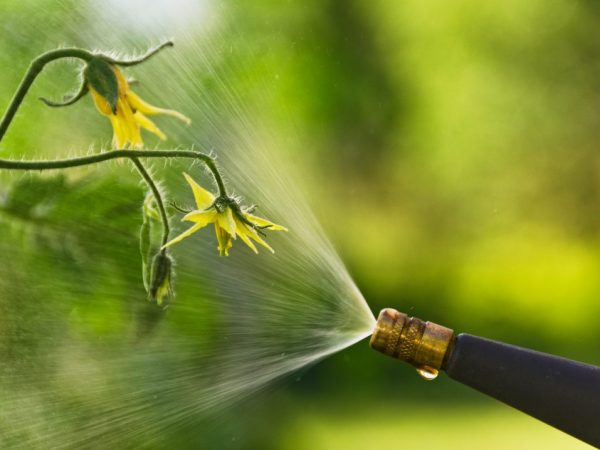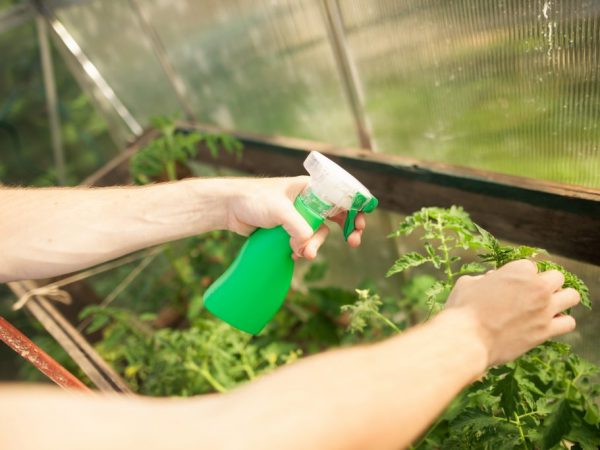The use of hydrogen peroxide for tomatoes
Today there are a huge number of ways to fertilize or grow plants. Fertilizer such as hydrogen peroxide is very popular. Hydrogen peroxide for tomatoes is a disinfectant that can provide plant resistance to many diseases.

The use of hydrogen peroxide for tomatoes
Beneficial features
The use of peroxide has the following advantages:
- the ability to disinfect injuries and damage to plants;
- after irrigation with the help of the drug, the root system receives more air;
- when processing planting material, the germination rates increase significantly;
- if foliage is sprayed, the plant will receive more oxygen;
- the ability to remove all bacteria and negative trace elements in the soil;
- prevention of diseases such as late blight or powdery mildew.
Hydrogen peroxide looks like ordinary water. But it contains more oxygen atoms.
Tatiana Orlova (Candidate of Agricultural Sciences):
The formula for water is H2O, the formula for hydrogen peroxide is H2O2. This extra oxygen atom makes it look like rainwater during a thunderstorm when it is saturated with ozone. This is why rainwater is especially beneficial for plants.
Soil treatment
Most of the bacteria that can cause disease are located inside the soil. For this reason, experienced agronomists always cultivate the soil before planting seeds or seedlings.
Soil cultivation can be carried out both before the introduction of planting materials into the greenhouse or open ground, and after. It is recommended to prepare the solution as follows: about 120 ml of pharmaceutical substance should be added to 6 liters of water. It is best to carry out processing in the spring season. Actions should be carried out 3-5 days before the intended landing. About 2 liters of the prepared solution is added to each well.
Seed treatment
Hydrogen peroxide can also be used for seed treatment. This is done in order to increase seed germination rates and rid them of bacteria.
Tatiana Orlova (Candidate of Agricultural Sciences):
A solution of hydrogen peroxide is also used to stimulate the germination of old, long-stored seeds. To do this, use a 0.4% solution, in which the seeds are soaked for 12-24 hours. After that, the seeds are dried without rinsing after the peroxide solution.
First, you need to prepare a 3% solution and wrap the seeds in a gauze cloth. After that, cheesecloth with seeds is placed in the solution for 15-20 minutes. After the specified time, the seeds are taken out and washed in running water. Now they need to be given a few hours to dry out.
Seed disinfection is carried out in order to reduce the risk of diseases in the early stages of germination. The thing is that fungal infections affect tomato plants the most.
The spores of such mushrooms can be dormant for several years, and after planting they begin to germinate and become more active.To avoid such a situation, carry out these activities.
Seedling processing

Top dressing stimulates plant growth
In order for the development of seedlings to occur correctly, they need an appropriate stimulant. Seedlings should be sprayed with a solution, which is prepared as follows: 2 liters of a water base should be mixed with 4 tbsp. l. hydrogen peroxide.
This substance can be used to water seedlings constantly, but with an interval of 1 week. As soon as you carry out such a top dressing, the seedlings will begin to grow almost immediately.
Tatiana Orlova (Candidate of Agricultural Sciences):
Chlorinated tap water is not suitable as a water base for preparing a hydrogen peroxide solution. It is best to use river, well water. Or to defend tap water for several days.
Processing adult bushes
Very often, peroxide (another name for peroxide) is used to disinfect tomato wounds. As soon as you treat a wound or a crack in the tomatoes, it is recommended to close the treated area with latex. In order for fungal infections not to affect the bushes, such treatment should be carried out throughout the growing season. The interval of procedures should be 1 time in 7-10 days. A solution for these purposes is prepared with the calculation of 30 ml of substance per 2 liters of warm water base.
It is better to water tomatoes with rainwater rather than tap water. Even though rainwater is more toxic due to environmental pollution. It is for this reason that peroxide disinfection is recommended. As a result of such watering, the plant improves its yield indicators and becomes more resistant to diseases. Also, the watering procedure allows you to disinfect the shoots and maintain the health of the root system.
You need to know certain rules:
- The depth of moisture penetration must be at least 9 cm.
- It is better to use warm, settled water.
- When you water the plant, remember that the soil should not be washed away by pressure and moisture should not get on the tops.
- Watering should be done rarely, but with a plentiful method.
- You need to water the tomato bushes once every 7 days.
- Watering activities should be carried out in the evening or morning, when the sun is not too hot.
- Use a spray bottle with fine but frequent holes. Protect the leaves from the substance.
You also need to pay attention to weather conditions. Do not spray in the scorching sun, rain or windy weather. This can lead to the drug getting on the tops and leading to its death.
Fight disease
The main enemies of tomatoes are late blight, root rot and white spot.
Late blight

You need to get rid of late blight as soon as possible.
Phytophthora is considered a fungal infection, the bacteria of which are found in the soil, greenhouse walls, or tools. If you notice the appearance of brown spots on the foliage or black spots on the fruits, you should immediately get rid of phytophthora. To do this, you need to dilute 2 salt spoons of peroxide in 2 liters of water and treat the affected areas.
Root rot
Root rot is characterized by the appearance of black spots in the root area. As a result, this can lead to the death of the bush. Therefore, it is necessary to spray at an early stage of the disease. This will get rid of all the spores that provoke the development of root rot. You need to prepare a solution that consists of 20 ml of peroxide and 1.5 liters of warm water.
White spot
Signs of white spot are white spots with small brown edges, which later begin to take on a brown tint. Ultimately, the affected leaves will completely deform and fall off. The development of the disease occurs in a humid environment. Spraying with hydrogen peroxide should be carried out once every 2-3 days. You can also enhance the effect of medicinal preparations.
Conclusion
Hydrogen peroxide treats seeds to accelerate their germination, is used to treat diseases and to saturate the soil with oxygen. When the plant begins to develop, peroxide can be added to the water for irrigation purposes. Also, such a substance is used.
If you decide to water the tomatoes with such a remedy, do it right and then your harvest will pleasantly surprise you.



